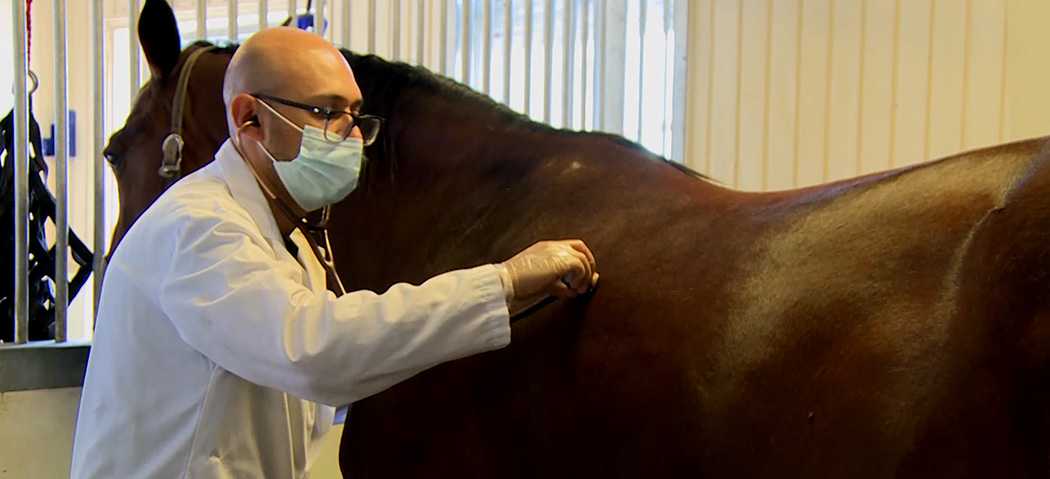
OVC Researcher Aims To Improve Survival Of Critically Ill Horses And Foals
February 18, 2022
Ongoing research at the Ontario Veterinary College (OVC) led by Dr. Diego Gomez aims to understand the changes in gut bacteria of horses with diarrhea (colitis) and improve fluid therapy in dehydrated critically ill foals.
 Gomez, a professor in OVC’s Department of Clinical Studies at the University of Guelph, is leading three studies; two that focus on improving fluid therapy for critically ill foals and one that aims to better understand colitis, an inflammatory disease that causes injury to the lining of the large intestine, in horses.
Gomez, a professor in OVC’s Department of Clinical Studies at the University of Guelph, is leading three studies; two that focus on improving fluid therapy for critically ill foals and one that aims to better understand colitis, an inflammatory disease that causes injury to the lining of the large intestine, in horses.
Colitis is characterized by severe diarrhea and some affected horses do not survive or may develop laminitis, inflammation of the tissue inside their hoofs. Gomez and his team will study the changes in gut bacteria to help them understand why this happens. The ultimate goal of this study is to develop a rapid and cost-effective treatment that will reduce horse mortality due to acute diarrhea.
Their first objective is to analyze the gut microbiota, beneficial microorganisms that are naturally present throughout the digestive tract, in healthy horses as well as those with severe diarrhea. Gomez will then compare the gut microbiota to better understand which microorganisms are part of a healthy digestive tract, and how that might change in horses with diarrhea. Gomez says, “Determining this could affect the future of probiotics and how to re-establish healthy gut bacteria.”
They will also compare the gut microbiota between horses that survived severe diarrhea and those that did not, as well as the gut microbiota of horses with colitis that develop laminitis and those that did not. This will inform cost-effective treatments that recover the “normal” gut bacteria of horses and speed recovery in those with diarrhea. If a bacteria link is discovered, it could lead to the development of rapid diagnostic tests that can be used on fecal samples to predict whether a horse will survive a diagnosis of colitis.
In his research focusing on fluid therapy for foals, one of Gomez’s projects aims to fill the knowledge gap on veterinary guidelines for maintaining intravenous fluids in critically ill foals. Foals often receive fluids to correct and maintain normal hydration status, but current protocols for delivery may be outdated. Historically, administration of low-sodium (hypotonic) fluids, as opposed to fluids with sodium concentration similar to that in the blood (isotonic fluids), was recommended.
However, it has been recently noted in human medicine that this can cause life-threateningly low blood sodium levels. Doctors now administer isotonic fluids with higher sodium levels more frequently. Fluids with low sodium levels are still administered to foals, following guidelines previously extrapolated from human medicine. Gomez and his team aim to compare this current delivery of fluids to that of isotonic fluid therapy by studying important health markers.
“One aim of this study is to provide data to support evidence-based protocols and the development of guidelines for fluid therapy in critically ill foals to help reduce mortality rates,” Gomez explains.
In a second study on fluid therapy for foals, Gomez is looking at the integrity of the blood vessels before and after fluid resuscitation. Fluids are often administered intravenously, injected within a vein and directly into the bloodstream, to aid in the resuscitation of critically ill foals. This is one of the more important interventions in the management of foals that arrive at emergency hospitals.
However, in the process of trying to maintain fluid levels, it is possible that fluids may damage the Endothelial glycocalyx (EG) – a thin, gel-like layer covering the internal surface of blood vessels that regulates the transport of fluids, proteins, oxygen, and nutrients from the blood to the tissues. In human studies, there is some evidence that administration of large volumes of fluids during life-saving procedures can damage this gel-like layer and impact the function of the lungs, liver, kidney, and brain. Increased levels of markers associated with EG damage in the blood have also been linked to an increased risk of death. “While these markers are known in human medicine, they are not in critically ill foals,” says Gomez.
Gomez and his team aim to determine the blood levels of EG damage markers in critically ill foals, before and after fluid resuscitation. This will help to determine whether this practice can worsen the integrity of the blood vessels, as well as causing further damage to the EG. Evidence-based guidelines for fluid administration can then be generated, once these blood level markers are determined.
“The research conducted by our group is clinically applicable and aims to improve the approaches that we use to treat sick horses and foals,” says Gomez. “The ultimate goal is to decrease the mortality rate, having a positive emotional and economic impact for the horse owner.”
This was adapted for the OVC website from a story published originally on Equine Guelph's Horse Portal.
.png)